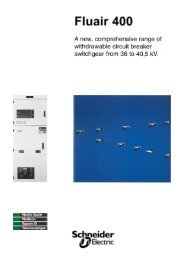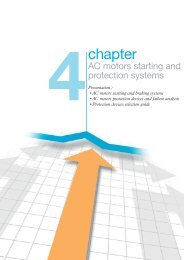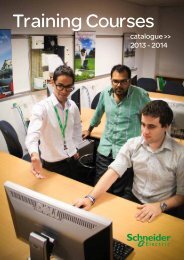Connect - Schneider Electric
Connect - Schneider Electric
Connect - Schneider Electric
Create successful ePaper yourself
Turn your PDF publications into a flip-book with our unique Google optimized e-Paper software.
These procedures include quarterly business reviews in which<br />
performance and projections are monitored, in terms of activity,<br />
action plans, results to date and forecasts, at all organisational levels<br />
of the Group (see the section entitled “Internal Control and Risk<br />
Management”). The Group also has the necessary competencies<br />
to manage these risks, mainly through its central functions (fi nance,<br />
legal, tax and customs).<br />
The protection provided by these measures may nevertheless<br />
prove to be inadequate.<br />
The growth and success of the Group’s<br />
products depend on its ability to develop new<br />
products and services and adapt to market and<br />
customer needs<br />
The sectors in which the Group operates experience rapid<br />
and signifi cant changes due to the introduction of innovative<br />
technologies. Introducing new technology products and innovative<br />
services, which <strong>Schneider</strong> <strong>Electric</strong> must do on an ongoing basis<br />
to meet customers’ needs, requires a signifi cant commitment to<br />
research and development, which may not result in success. The<br />
Group’s revenue and margins may suffer if it invests in technologies<br />
that do not function as expected or are not accepted in the<br />
marketplace or if its products, systems or service offers are not<br />
brought to market in a timely manner, become obsolete or are not<br />
responsive to our customers’ requirements.<br />
To meet these challenges, the Group has an R&D budget which,<br />
at 4 to 5% of revenue, is among the highest in the industry. R&D<br />
and forward-looking engineering involves some 11 ,0 00 employees<br />
around the world, a number of them in development centres located<br />
in over 26 countries. This ongoing commitment has allowed the<br />
Group to accelerate time to market and leverage the technology of<br />
strategic partners with whom it has also forged alliances to expand<br />
its line up or geographic coverage. The Group has brought together<br />
all of its electrotechnical, electronic, electromechanical, software<br />
and other technical competencies by creating technology parks in<br />
China, the US, France and Japan.<br />
Support centres have also been established in Mexico, India and<br />
China to provide the technology parks with additional skills and<br />
development capacity at a very competitive cost.<br />
The Group’s business growth depends on its ability to develop,<br />
deepen and enhance customer relationships. The Group must<br />
constantly offer customers innovative solutions built around<br />
high-quality products and services incorporating leading-edge<br />
technologies that are closely tailored to customer needs and<br />
expectations. However, the Group does not have any exposure to<br />
a particular customer. Its ten largest customers represent less than<br />
25% of total revenue.<br />
Increasing customer satisfaction rates represents an important<br />
source of competitive advantage for the Group. It closely tracks the<br />
results of the quarterly surveys conducted in more than 80 countries<br />
among all types of customers. Improvement targets are set for each<br />
country as part of the One company program, backed by specifi c<br />
action plans and progress monitoring procedures.<br />
DESCRIPTION OF THE GROUP, AND ITS STRATEGY, MARKETS AND BUSINESSES<br />
RISK FACTORS<br />
<strong>Schneider</strong> <strong>Electric</strong>’s strategy involves growth<br />
through acquisitions, joint ventures and<br />
mergers that may be difficult to execute<br />
The Group’s strategy involves strengthening its capabilities through<br />
acquisitions, strategic alliances, joint ventures and mergers.<br />
Changes in the scope of consolidation during 2011 are described<br />
in note 2 to the consolidated fi nancial statements (Chapter 5).<br />
External growth projects are examined in detail by the businesses<br />
and corporate functions (strategy, fi nance, legal affairs, tax and<br />
human resources) concerned, under a rigorous internal process<br />
developed and led at Group level. A launch committee is<br />
responsible for initiating the review process to identify the risks and<br />
opportunities associated with each external growth project, while a<br />
number of validation committees review the results on an ongoing<br />
basis. Projects that successfully come through the review process<br />
are submitted for approval to the Group Acquisitions Committee<br />
made up of the main members of senior management. The largest<br />
projects require the prior approval of the Management Board and,<br />
in some cases, the Supervisory Board.<br />
External growth transactions are inherently risky because of<br />
the diffi culties that may arise in integrating people, operations,<br />
technologies and products, and the related acquisition,<br />
administrative and other costs.<br />
This is why an integration procedure for new acquisitions has<br />
been drawn up. The integration of newly acquired businesses is a<br />
process that extends over a period of six to 24 months depending<br />
on the type and size of the newly acquired unit. The integration<br />
scenario for each acquisition varies depending on whether the<br />
business was acquired to strengthen or extend the Group’s existing<br />
line-up or enter a new segment. There are a number of different<br />
integration scenarios, ranging from total integration to separate<br />
organisation. An integration plan is drawn up for each acquisition<br />
and submitted to the Acquisitions Committee for approval. The<br />
plan is implemented by an integration manager who reports to a<br />
Steering Committee that initially meets at monthly intervals and then<br />
on a quarterly basis.<br />
The unit that presents the external growth project is accountable to<br />
the Group’s senior management for meeting clearly defi ned business<br />
plan targets covering the performance of the new business and<br />
expected synergies with existing businesses. Actual performance is<br />
measured against business plan targets during quarterly business<br />
reviews and, for the largest acquisitions, by the Management Board<br />
and Supervisory Board.<br />
Value in use is determined by discounting estimated future cash<br />
fl ows that will be generated by the tested assets, generally over a<br />
period of not more than fi ve years. These future cash fl ows are based<br />
on Group management’s economic assumptions and operating<br />
forecasts. The discount rate corresponds to <strong>Schneider</strong> <strong>Electric</strong>’s<br />
weighted average cost of capital (WACC) at the measurement<br />
date plus a risk premium depending on the region in question<br />
(local risk- free rate), the nature of the target’s business (appropriate<br />
beta), and the structure of the fi nancing (taking into account the<br />
debt to equity ratio and risk premium on the debt). The Group’s<br />
WACC stood at 8.1% at December 31, 2011, slightly down on the<br />
2010 fi gure. The perpetuity growth rate was 2%, unchanged on the<br />
previous fi nancial year.<br />
Goodwill is allocated to a Cash Generating Unit (CGU) when initially<br />
recognised. The CGU allocation is done on the same basis as used<br />
by Group management to monitor operations and assess synergies<br />
deriving from acquisitions. Impairment tests are performed at the<br />
level of the cash generating unit in 2011 (CGU), i.e. the Power,<br />
2011 REGISTRATION DOCUMENT SCHNEIDER ELECTRIC<br />
35<br />
1

















